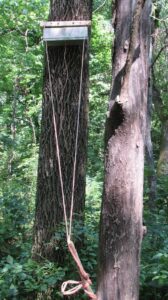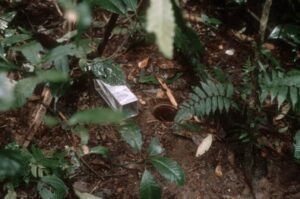Back to: ZOOLOGY 500 Level
Welcome to class!
Hello, future wildlife expert! I hope you’re excited because today’s lesson is all about three important tools ecologists use to study animals—especially those that are shy, small, or active at night. These are pitfall traps, Sherman traps, and camera traps. Understanding how to use these tools will make your fieldwork more effective and help you learn amazing things about wildlife right here in Nigeria and across Africa.
Pitfall Traps, Sherman Traps, Camera Traps
What Are Pitfall Traps?
Pitfall traps are simple but clever devices used to catch small ground-dwelling animals like insects, frogs, or small reptiles. They work by digging a hole in the ground and placing a container inside it so animals fall in but can’t escape easily. The trap is usually covered with a small roof or leaf litter to protect the animals from rain and predators.

Imagine you are studying ants in a forest in Oyo State. Using pitfall traps, you can collect different species safely and release them after counting. This helps you understand what types of insects live in that area.
What Are Sherman Traps?
Sherman traps are small, portable cages used to catch small mammals such as rodents. They are designed to capture animals alive without harm, so scientists can study and release them safely. These traps often have a bait inside to attract animals and a spring door that closes once the animal enters.
Think about studying rodents around farms in Kaduna. Using Sherman traps, you can learn about the kinds of rodents that live there, their behaviour, and population size without hurting them.
What Are Camera Traps?
Camera traps are motion-sensitive cameras placed in the wild that take pictures or videos automatically when an animal passes by. They are excellent for studying larger or elusive animals that are hard to catch or see, such as antelopes, monkeys, or even leopards.
For example, in Cross River National Park, camera traps help scientists monitor rare animals without disturbing their natural behaviour. The images collected provide valuable information on animal presence, numbers, and activities.
Why These Tools Matter
These traps allow ecologists to:
Collect data without harming animals
Study species that are difficult to observe directly
Gather information day and night, even in dense forests
Make better conservation decisions based on real data

Real-Life Example
Aminu, a Zoology student at Ahmadu Bello University, used Sherman traps to study rodent populations in a farming community. He set up the traps near homes and fields, checked them daily, recorded the species caught, and safely released them. He also used camera traps to monitor nocturnal animals like genets. His findings helped local farmers understand pest behaviour better.
Summary
- Pitfall traps catch small ground animals by making them fall into hidden containers.
- Sherman traps are live-capture cages for small mammals like rodents.
- Camera traps are motion-activated cameras that capture images or videos of wildlife.
- These tools provide safe, effective ways to study animals in their natural habitats.
Evaluation
- Describe how a pitfall trap works and what kind of animals it is used for.
- What is the main advantage of Sherman traps in wildlife studies?
- How do camera traps help ecologists study elusive animals?
- Suggest one ethical consideration when using these traps in the field.
You are becoming a skilled wildlife researcher! Using these tools thoughtfully shows your respect for nature and your dedication to learning. Afrilearn is proud to support your growth—keep going, because you are making a real difference already!
